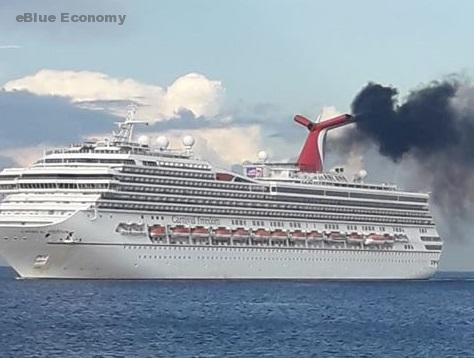By Jim Walker
This past week, the Carnival Freedom cruise ship was photographed belching thick black smoke while arriving in George Town, Grand Cayman.
The photograph was taken by an individual who wishes to remain anonymous.
It was taken on Tuesday, October 29th. The twelve-year-old Carnival ship left Galveston, Texas on the evening of October 27th and arrived in George Town on Tuesday morning.
explained that the Carnival Freedom had just arrived in George Town and was on the way to the anchorage area to be tendered when it started smoking heavily from the exhaust stacks.
Other Recent Carnival Air Emissions
This was not the first time that a Carnival ship was filmed belching thick smoke near the port.
This past summer, the webcam in the port of Nassau in the Bahamas showed the Carnival Victory belching thick black smoke from its funnel for around an hour. PTZtv, which operates
The video initially shows a Royal Caribbean cruise ship (Navigator of the Seas) in the foreground, but the pollution is actually coming from the funnel of a Carnival cruise ship (Carnival Victory) which was docked behind the Royal Caribbean ship.
The responses on social media to the spectacle involving the Carnival Victory were predictable. Some suggested that this was somehow normal emissions coming from the engines which were blowing soot loose, or perhaps the boilers needed minor maintenance or adjustment.
Carnival Corporation has been caught violating air emission laws in the past several years while on probation for environmental crimes. The Miami Herald reported that the Carnival P&O Azura burned heavy fuel oil for 16 hours while traveling through Iceland’s Environmental Protection Zone. The heavy fuel oil that many cruise ships use is high in sulphur. Sulphur emissions from ship exhausts are linked to thousands of premature deaths from lung cancer, cardiovascular disease, pulmonary problems, and childhood asthma cases annually.
A Brief History of Carnival Corporation’s Air and Water Pollution
In the last three years, the U.S. Department of Justice (DOJ) levied record fines totalling $60,000,000 against Carnival Corporation. Carnival-owned Princess Cruises pleaded guilty in December of 2016 to widespread pollution crimes involving the use of secret bypass valves on five Princess cruise ships to discharge oil directly into the water around the world, as well as conspiracy and obstruction of justice. The DOJ fined Carnival $40,000,000.
More recently, the DOJ levied an additional $20,000,000 fine against Carnival Corporation after the U.S. government caught the cruise giant of “repeatedly” discharging food which was mixed with plastic waste, metals and other non-food items in violation of its probation.
In 2002, Carnival pled guilty to numerous felonies after being caught discharging oily waste into the sea. Carnival reportedly routinely falsified its oil record books in order to conceal its illegal practices. The U.S. Government leveled a $18,000,000 fine and placed Carnival on probation.
In 1998, the DOJ fined Carnival Corporation-owned brand, Holland America Line, $2,000,000 after catching it discharging oily water without the use of an oil-water separator.
In 1993, the U.S. charged Princess Cruises (which Carnival subsequently purchased) with deliberately dumping plastic wastes overboard from its ships in violation of MARPOL and the Act of Prevent Pollution from Ships and fined it $500,000 in the Southern District of Florida.
In sum, Carnival has been continuously polluting the air and water for thirty years, despite over $80,000,000 in fines.
Environmental Dodges and Cheat Devices
Carnival prides itself on being the leader in using what it calls “advanced air quality systems” (a/k/a “scrubbers”) which it uses on 85 of its 102 ships, according to a recent article in Skift. Many critics describe scrubbers as “cheat devices” which turn air pollution into water pollution by scrubbing the sulfer dioxide and non-combustible particles from the smokestacks and discharding the toxic sludge into the water.
The upcoming IMO regulations, which are effective in January 2020, require ships to use fuel oil with a sulphur content of no more than 0.5 %). However, the IMO permitted a loophole requested by the shipping industry. A cruise line can continue to use the lower cost but high-sulfur fuel, as long as they install an exhaust gas cleaning system, (i.e., a “scrubber”) on the ship to maintain emissions at the same levels as low-sulfur fuel. Rather than purchasing higher prices low sulphur fuels, Carnival has chosen to use scrubbers because it is cheaper, notwithstanding the harmful effect to the water and ocean life by discharding the toxic wastewater.
Carnival Status Conference Scheduled for December 2019:
Yesterday, Judge Seitz scheduled a hearing for December 19th, at 10:00 a.m. in the U.S. Government’s case against Carnival Corporation to discuss, among other issues, “compliance challenges” regarding incidents mentioned in Carnival’s Quarterly Tracking Chart filings, including air emissions, as well as the discharge of non-food items including plastics in food waste, and the discharge of other prohibited waste streams, including ballast water, black water (sewage), garbage, greywater, and oil and oily wastes.
Have a thought? Please leave one below or join the discussion on our Facebook page.
November 4, 2019 Update: Carnival Cruise Line responded to a FOX News reporter who covered the incident in an article published today titled: Carnival Cruise Line says smoke seen in Carnival Freedom photo was caused by engine turbocharger malfunction. Carnival claims that the “Carnival Freedom emitted dark smoke from the funnel. This was related to a malfunction of an engine turbocharger (which) was quickly shut down and the smoke ceased.”
Photo credits: Carnival Freedom – Anonymous; Carnival Victory – PTZtv.














